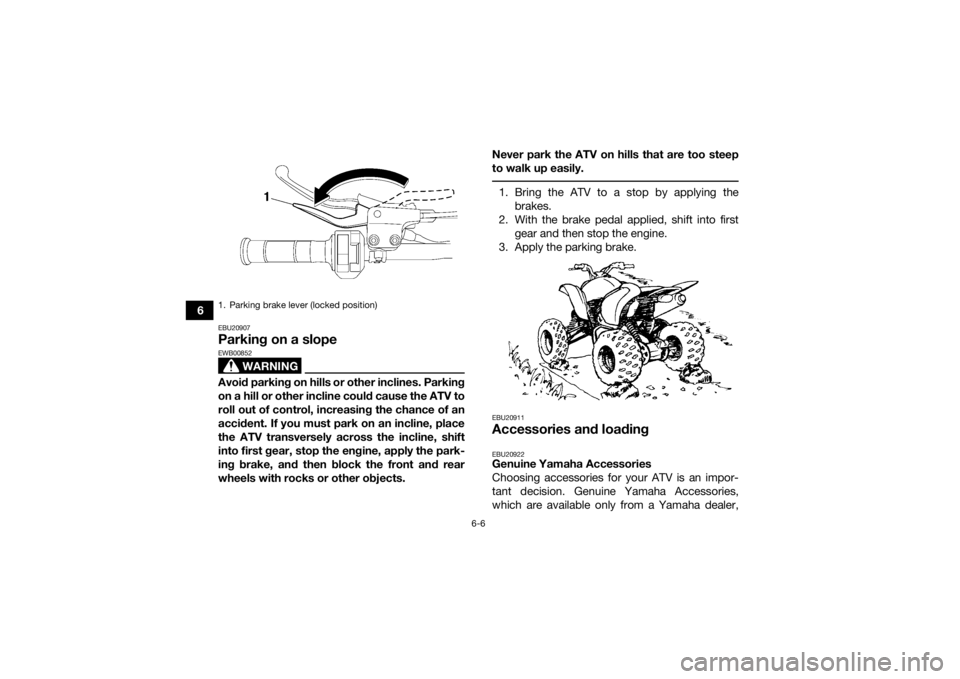2017 YAMAHA YFM700R parking brake
[x] Cancel search: parking brakePage 68 of 160

6-6
6
EBU20907Parking on a slope
WARNING
EWB00852Avoid parking on hills or other inclines. Parking
on a hill or other incline could cause the ATV to
roll out of control, increasing the chance of an
accident. If you must park on an incline, place
the ATV transversely across the incline, shift
into first gear, stop the engine, apply the park-
ing brake, and then block the front and rear
wheels with rocks or other objects.Never park the ATV on hills that are too steep
to walk up easily.
1. Bring the ATV to a stop by applying the
brakes.
2. With the brake pedal applied, shift into first gear and then stop the engine.
3. Apply the parking brake.EBU20911Accessories and loadingEBU20922Genuine Yamaha Accessories
Choosing accessories for your ATV is an impor-
tant decision. Genuine Yamaha Accessories,
which are available only from a Yamaha dealer,
1. Parking brake lever (locked position)U2LS62E0.book Page 6 Thursday, February 25, 2016 8:44 AM
Page 81 of 160

7-11
7
Select a large, flat, unpaved area to become famil-
iar with your ATV. Make sure that this area is free
of obstacles and other riders. You should practice
control of the throttle, brakes, shifting procedures,
and turning techniques in this area before trying
more difficult terrain.
Set the parking brake and follow the instruction on
page 6-1 to start the engine. Once it has warmed
up you are ready to begin riding your ATV. As you
get on the ATV, be sure not to accidentally move
the shift pedal. With the engine idling, pull the
clutch lever to disengage the clutch and shift into
1st gear, and then release the parking brake.
Open the throttle gradually, and at the same time,
release the clutch lever slowly. Once the ATV has
attained adequate speed, release the throttle lever
and at the same time, quickly pull in the clutch le-
ver and shift into 2nd gear. Open the throttle part
way and gradually release the clutch.
WARNING!
If the throttle is applied too abruptly or if the
throttle is not released during shifting, or if the
shift pedal is not released before applying the
throttle, the front wheels may lift off the
ground, resulting in a loss of directional con- trol.
[EWB02632]
NOTICE: Do not shift gears without
releasing the throttle. Damage to the engine or
drive train may occur.
[ECB01072]
Use this same procedure as you move into the
higher gears. Be sure to coordinate the use of the
throttle and shift pedal properly.
Avoid higher speeds until you are thoroughly fa-
miliar with the operation of your ATV.
When slowing down or stopping, release the
throttle and apply the brakes smoothly and evenly.
As you slow down, shift to a lower gear. Be sure
that the engine has sufficiently slowed before en-
gaging a lower gear. Improper use of the brakes or
shifting can cause the tires to lose traction, reduc-
ing control and increasing the possibility of an ac-
cident.
TURNING YOUR ATV
WARNING
EWB01772Always follow proper procedures for turning as
described in this Owner’s Manual. Practice
turning at low speeds before attempting to turn
at faster speeds. Do not turn at speeds too fast
for your skills or the conditions. ATV could go
out of control, causing a collision or overturn.
U2LS62E0.book Page 11 Thursday, February 25, 2016 8:44 AM
Page 85 of 160

7-15
7
It is important when climbing a hill to make sure
that your weight is transferred forward on the ATV.
This can be accomplished by leaning forward and,
on steeper inclines, standing on the footrests and
leaning forward over the handlebars. Whenever
possible, ride straight up hills.
Slow down when you reach the crest of the hill if
you cannot see clearly what is on the other side –
there could be another person, an obstacle, or a
sharp drop-off. Use common sense and remem-
ber that some hills are too steep for you to climb
or descend.
If you are climbing a hill and you find that you have
not properly judged your ability to make it to the
top, you should turn the ATV around while you still
have forward motion (provided you have the room
to do so) and go down the hill.
If your ATV has stalled or stopped and you believe
you can continue up the hill, restart carefully to
make sure you do not lift the front wheels which
could cause you to lose control. If you are unable
to continue up the hill, dismount the ATV on the
uphill side. Physically turn the ATV around and
then descend the hill. If you start to roll backwards, DO NOT apply the
rear brake, and apply the front brake gradually.
The ATV could easily tip over backwards. When
fully stopped, apply the rear brake as well, and
then lock the parking brake. Dismount the ATV im-
mediately on the uphill side or to a side if pointed
straight uphill. Turn the ATV around and remount,
following the procedure described in the Owner’s
Manual.
WARNING! Stalling, rolling backwards
or improperly dismounting while climbing a hill
could result in ATV overturning. If you cannot
control the ATV, dismount immediately on the
uphill side.
[EWB01803]
U2LS62E0.book Page 15 Thursday, February 25, 2016 8:44 AM
Page 98 of 160

8-6
8
5*Brake hoses • Check for cracks or other damage, and replace if
necessary. √√√√
• Replace. Every 4 years
6 *Brake fluid • Change. Every 2 years
7 *Parking brake • Check operation and adjust if necessary. √√√√√
8 *Wheels • Check runout and for damage, and replace if nec-
essary. √ √√√
9 *Tires • Check tread depth and for damage, and replace if
necessary.
• Check air pressure and balance, and correct if necessary. √ √√√
10 *Wheel hub bearings • Check for looseness or damage, and replace if
necessary. √ √√√
11 *Swingarm pivots • Check operation and for excessive play, and re-
place bearings if necessary.
• Lubricate with lithium-soap-based grease. √√√
12 *Upper and lower
arm pivots • Lubricate with lithium-soap-based grease.
√√√
13 Drive chain • Check chain slack and adjust if necessary.
• Check rear wheel alignment and correct if neces-
sary.
• Clean and lubricate. √√√√√
NO. ITEM
CHECK OR MAINTENANCE
JOB INITIAL EVERY
Whichev-
er comes first month136612
km (mi) 320
(200) 1300
(800) 2500
(1600) 2500
(1600) 5000
(3200)
hours 20 80 160 160 320U2LS62E0.book Page 6 Thursday, February 25, 2016 8:44 AM
Page 126 of 160

8-34
8
EBU24614Checking the brake pedal heightThe brake pedal height must be checked and, if
necessary, adjusted at the intervals specified in
the periodic maintenance and lubrication chart.
The top of the brake pedal should be positioned
15.3 mm (0.60 in) below the top of the footrest as
shown. If the brake pedal is not positioned as
specified, have a Yamaha dealer adjust it.
EBU24716Adjusting the parking brake free playThe parking brake free play must be checked and,
if necessary, adjusted at the intervals specified in
the periodic maintenance and lubrication chart.
Cable length “A” should measure 47–51 mm
(1.85–2.01 in). Adjust the parking brake free play
as follows.
1. No brake lever free play
1. Brake pedal height
1
U2LS62E0.book Page 34 Thursday, February 25, 2016 8:44 AM
Page 127 of 160

8-35
8
1. Release the parking brake by moving the
parking brake lever to the right.
2. Fully loosen the locknut and the adjusting bolt at the rear brake caliper.
3. Slide the rubber cover back at the brake ca- ble.
4. Loosen the locknut.
5. Turn the parking brake free play adjusting nut in direction (a) to increase the cable length,
and in direction (b) to decrease it.
TIPIf the cable length cannot be adjusted to specifi-
cation, consult a Yamaha dealer. 6. Tighten the locknut on the brake cable.
7. Slide the rubber cover to its original position.
8. Turn in the adjusting bolt at the rear brake cal-iper until it feels tight, then turn it out 1/8 turn
and tighten its locknut to the specified torque.
NOTICE: When tightening the locknut,
1. Adjusting bolt
2. Cable length “A”
3. Locknut
1
2
3
1. Rubber cover
2. Parking brake free play adjusting nut
3. Locknut
1
(b)
(a) 2
3
U2LS62E0.book Page 35 Thursday, February 25, 2016 8:44 AM
Page 128 of 160
![YAMAHA YFM700R 2017 Owners Manual 8-36
8hold the adjusting bolt with a wrench so
that it does not turn together with the lock-
nut.
[ECB00522]
WARNING
EWB02091Operating with improperly serviced or adjust-
ed brakes could cause the br YAMAHA YFM700R 2017 Owners Manual 8-36
8hold the adjusting bolt with a wrench so
that it does not turn together with the lock-
nut.
[ECB00522]
WARNING
EWB02091Operating with improperly serviced or adjust-
ed brakes could cause the br](/manual-img/51/53753/w960_53753-127.png)
8-36
8hold the adjusting bolt with a wrench so
that it does not turn together with the lock-
nut.
[ECB00522]
WARNING
EWB02091Operating with improperly serviced or adjust-
ed brakes could cause the brakes to malfunc-
tion, resulting in reduced braking
performance. This could increase the chance
of a collision or accident. After adjusting the
parking brake free play, block the rear of the
ATV off the ground and spin the rear wheels.
Check to make sure there is no brake drag. If
brake drag is noticed, perform the adjustment
again. EBU24744Brake light switchesThe brake light, which is activated by the brake
pedal and brake lever, should come on just before
braking takes effect. The brake light switch for the brake pedal can be
adjusted as follows, but the front brake light
switch should be adjusted by a Yamaha dealer.
Turn the rear brake light switch adjusting nut while
holding the brake light switch in place. To make
the brake light come on earlier, turn the adjusting
nut in direction (a). To make the brake light come
on later, turn the adjusting nut in direction (b).
EBU29752Adjusting the clutch lever free playThe clutch lever free play must be checked and, if
necessary, adjusted at the intervals specified in
the periodic maintenance and lubrication chart.
Tightening torque:
Locknut (rear brake caliper):16 N·m (1.6 kgf·m, 12 lb·ft)1. Rear brake light switch
2. Rear brake light switch adjusting nut
1
2
(a)
(b)
U2LS62E0.book Page 36 Thursday, February 25, 2016 8:44 AM
Page 159 of 160

12-2
12
NNeutral indicator light ..................................................... 4-2OOwner’s manual and tool kit .......................................... 8-2PPanel, removing and installing ..................................... 8-10
Parking ........................................................................... 6-5
Parking brake free play, adjusting ............................... 8-34
Parking brake lever ........................................................ 4-8
Parking on a slope ......................................................... 6-6
Part locations ................................................................. 3-1RReverse indicator light ................................................... 4-2
Reverse knob ................................................................. 4-9
Reverse knob and driving in reverse ............................. 6-4
Reverse lock release cable, adjusting ......................... 8-29
Riding your ATV ............................................................. 7-1SSafety information .......................................................... 2-1
Seat .............................................................................. 4-12
Self-diagnosis device .................................................... 4-3
Shifting ........................................................................... 6-2
Shift pedal ...................................................................... 4-9
Shift pedal, checking ................................................... 8-41
Shock absorber assemblies, adjusting the front (YFM70RSBH) ........................................................... 4-13
Shock absorber assemblies, adjusting the front
(YFM70RSSH/YFM70RSXH) ..................................... 4-15
Shock absorber assembly, adjusting the rear (YFM70RSBH) ........................................................... 4-20 Shock absorber assembly, adjusting the rear
(YFM70RSSH/YFM70RSXH) ..................................... 4-22
Spark arrester, cleaning ............................................... 8-25
Spark plug, checking ................................................... 8-10
Specifications .............................................................. 10-1
Speed limiter .................................................................. 4-5
Start switch .................................................................... 4-4
Steering shaft, lubricating ............................................ 8-45
Storage .......................................................................... 9-2
Suspension, lubricating the upper and lower arm pivots ......................................................................... 8-44
Suspension relay arm and connecting arm pivoting points, lubricating the rear ......................................... 8-43
Swingarm pivots, lubricating ....................................... 8-42
TTail/brake light ............................................................. 8-52
Throttle lever ........................................................... 4-4, 5-5
Throttle lever free play, adjusting ................................ 8-28
Tires ............................................................................... 5-5
Troubleshooting ........................................................... 8-53
Troubleshooting charts ................................................ 8-54VValve clearance ............................................................ 8-29
Vehicle identification number ...................................... 11-1WWheel hub bearings, checking .................................... 8-42
Wheel, installing ........................................................... 8-52
Wheel, removing .......................................................... 8-52
U2LS62E0.book Page 2 Thursday, February 25, 2016 8:44 AM